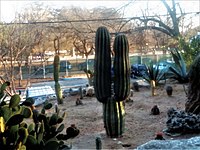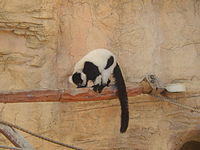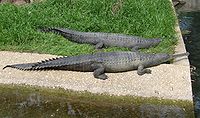|
San Antonio Zoo
The San Antonio Zoo is a 57-acre (23 ha) zoo located in Brackenridge Park in San Antonio, Texas, United States. It is home to over 750 species, some of which are endangered or extinct in the wild, and has an annual attendance of more than 1 million.[4][5] The zoo also hosts the Richard Friedrich Aquarium, which opened in 1948.[6] It was the only aquarium in the city until SeaWorld San Antonio opened in 1988.[citation needed] It also runs non-animal attractions, such as the San Antonio Zoo Train, which first opened in 1956.[7] DescriptionThe San Antonio Zoo spans 57 acres (23 ha) in Brackenridge Park, located in the city's Midtown area. It is accredited through the Association of Zoos and Aquariums (AZA)[2] and the Zoological Association of America (ZAA).[3] Exhibits and other buildings  Monkey House and Commissary
The Monkey House and Commissary at the San Antonio Zoo was built between 1935 and 1937. It was designed by San Antonio architecture firm Adams & Adams in the Spanish Revival style. Throughout the decades, it has variably served as an animal commissary, veterinary office, staff offices, and the zoo's monkey house. It was listed on the National Register of Historic Places (NRHP) on April 4, 2024, for its architectural value.[8] The building and surrounding plaza were renovated in 2023 ahead of the NRHP nomination, and the structure itself was converted into concessions and restrooms.[9] San Antonio Zoo Train The San Antonio Zoo Train, formerly the Brackenridge Eagle, is a 2 ft (610 mm) narrow gauge miniature train that connects the zoo to various points of interest within Brackenridge Park. The railway opened in 1956 and had 1 million passengers during its first two years of operation.[7] HistoryOpeningWhat is now known as the San Antonio Zoo began in 1914 when George Washington Brackenridge, one of the city's leading citizens, placed several animals, including bison, deer, monkeys, African lions, and bears, on land he had deeded to the city. The land became Brackenridge Park and Golf Course.[4] The San Antonio Zoo opened two of the first cageless exhibits in the United States in November 1929 that offered visitors views of the animals not available in caged exhibits. The Richard Friedrich Aquarium was dedicated in 1948, and the Hixon Bird House, funded through the efforts of Frederick C. Hixon, opened in 1966.[4] The San Antonio Zoo housed the first herd of addra gazelle in captivity in 1969 and continues to be active in the breeding program for the critically endangered species. Due to the former hoofstock quarantine point in San Antonio, the San Antonio Zoo has historically had a wide variety of hoofstock species. The Great (Little) Train RobberyOn July 18, 1970, two bandits held up the Brackenridge Eagle at gunpoint and robbed its passengers. Some passengers initially believed it was a stunt for a charity fundraiser. The robbers fled the scene with $500 ($3,923 in 2023), as well as car keys, checkbooks, and other valuables.[10] Ten days later, two soldiers from Fort Sam Houston, James R. Brown and Paul E. Smith, were apprehended for the crime. Both were discharged from the U.S. Army and later convicted; Smith was sentenced to 20 years and Brown to 10 years.[11][12] Dubbed "the Great (Little) Train Robbery", this holdup has remained the last train robbery in Texas.[12][13] 21st centuryPhase I of Africa Live!, which opened in 2008, brought a new exhibit for hippos with underwater viewing area and one for new Nile crocodiles as well as many other smaller animals. Phase II contains Angolan colobus monkeys, okapi, African hunting dogs, rock hyrax, and various species of birds contained in the second largest aviary in the world. The zoo opened Phase II of Africa Live! in 2010.[4] On June 18, 2013, a two-headed Texas river cooter turtle hatched. The turtle was named Thelma and Louise after the 1991 film.[14] Thelma and Louise died on July 29, 2014, from unknown causes.[15] Josh the African lion was permanently transferred to the Birmingham Zoo in April 2022 as part of the AZA's Species Survival Plan.[16] The zoo began construction of its new gorilla habitat, Congo Falls, in 2023. The zoo's previous gorilla habitat closed with the relocation of its last gorilla to the National Zoo in 1990.[17] The 2-acre (0.81 ha) exhibit is scheduled to open in late 2025.[18] In October 2024, San Antonio Zoo opened its expanded African habitat, the Naylor Savanna, which greatly increased exhibit space for African species and included a new giraffe barn. Upon its opening, the new habitat was the largest in the zoo's history.[19][20] The Spekboom Lodge, situated in the middle of the giraffe habitat, opened as a space for guests to rent a night in the zoo on November 1, 2024.[21] ConservationThe Center for Conservation and Research at the San Antonio Zoo is involved in breeding a number of endangered species including black rhino, leopard, golden lion tamarin, dama gazelle, Attwater's prairie chicken (housed and bred off-exhibit), black mangabey, African lion, black-footed ferret, Komodo dragon, Andean condor, and Caribbean flamingos. The zoo is also involved in the conservation of the Texas horned lizard through its Texas Horned Lizard Reintroduction Project, breeding and then releasing the animals back into their native habitat.[22] The project runs in collaboration with several organizations, including the Texas Parks and Wildlife Department and Zoo Miami.[23] As of 2024[update], the center had released 258 individuals into the wild.[24] IncidentsIn 1992, a zookeeper, Jubal Cox, was tossed by an Asian elephant and received fatal injuries. The zoo launched an investigation into the circumstances surrounding the incident and decided not to euthanize the elephant. Cox's death was the first in the zoo's history.[25] This incident marked the end of elephant rides at the zoo.[4] SpeciesThe San Antonio Zoo is home to over 3,500 animals belonging to 750 species.[5] Mammals
Birds
Reptiles 
Amphibians
See alsoReferences
External links
|
||||||||||||||||||||||||||||||||||||||||||||||||||
Portal di Ensiklopedia Dunia




